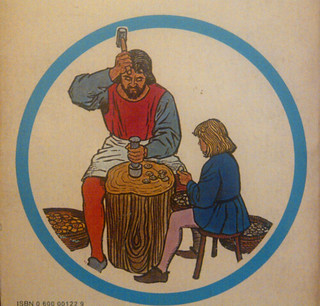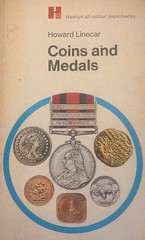
PREV ARTICLE
NEXT ARTICLE
FULL ISSUE
PREV FULL ISSUE
NUMISMATIC MENTORS AND STARTER BOOKS
Here are some more reader tributes to their numismatic mentors. -Editor
Ken Bressett's Mentor: Eric Newman
As a youngster living rather numismatically isolated in New Hampshire I knew of few others with my same interest in the hobby. In a rather audacious move I wrote a ‘blind’ letter to Eric Newman asking for information about the rare New Hampshire copper coin that he had in his collection. I explained that I wanted to learn more about these unusual coins and was trying to trace all known specimens. His response, in true Newman fashion, was to mail the coin to me for examination and study. It was the start of an extraordinary mentorship that has lasted ever since - 70 years! Eric’s in-depth knowledge of numismatics is phenomenal and he is always willing to share his information with others. I have been blessed to have had Eric as both an extraordinary mentor, and even more so as a lifelong friend. Dick Johnson's Medal Mentor: Julius Lauth
I must admit I had two mentors, one for coins and one for medals, but I learned a lot from a great many people along the way. My coin mentor was a co-worker in my father’s office who introduced me to coin collecting, taught me about mintmarks, condition, varieties and gave me a penny board and a Whitman Blue Book. That was in February 1939 when I was 9 years old. To learn more about coin collecting afterwards included self-teaching by reading numismatic literature. Although I did learn considerable from Walter Breen. He lived for a short time in Washington DC researching at the National Archives when I was there in the Air Force. My medal mentor was Julius Lauth, vice president and art director of Medallic Art Company. I realized the maximum amount of knowledge of coins is the minimum amount required for medals. There was so much more to learn about medals, particularly art medals. They are made on stronger presses –knuckle-joint or hydraulic instead of coining presses. There is considerable difference in relief. Medals are given a distinctive protective finish, occasionally in color, while coins are left unfinished, just as they come off the press. Medals are usually packaged in individual boxes with cotton protective layers. Coins are bagged to knock against each other. Even the condition is different between the two. Coins are graded by the basic fields without regard to those bagmarked nicks. Medals are graded by the presence of any nicks without regard to the basic surface (which is generally mint perfect as they do not circulate). Julius, as well as other co-workers at Medallic Art, were always patient with me as I asked so many questions. Even as a 20-year veteran coin collector, I had a lot to learn about the associated field of numismatics -- medals. I look back on 76 years of collecting and realize I had many mentors, most of these became long-lasting friends because we shared a common interest. I can number among those John J, Pittman, Eric Newman, Hans M.F. Schulman, James Kelly, John Jay Ford, Lee Hewitt, Daniel Friedenberg, George Fuld, Henry Grunthal, Cornelius Vermeule and perhaps half the names on the American Numismatic Association’s Wall of Fame. Bob Rhue's Mentor: Dan Brown
When I was ten years old back in '55 I walked into Dan Brown's coin shop in Denver, inquiring about how much my "treasure trove" of foreign coins that I had just gotten from my grandfather was worth. As nicely as he could, Dan told me "nothing." Although clearly disappointed, I got to looking in his cases and saw that I could buy six different dates of Indian pennies for 25C and a little blue Whitman book to put them in for another 25C. All I had to do was mow two lawns and I'd be off and running I figured. As my intense interest in coins continued to grow, Dan (as well as his wife Thelma who also worked in the shop), took me under his wing. He taught me many good lessons about quality versus quantity, eye appeal, and good value for the money. He trusted me to go through his safe at will, picking out coins for my budding collection. When I was in college he would send me coins on approval so that I could sell them to make extra money to buy more coins or to pay college expenses. At one point he even co-signed a loan at a bank for me, to give you an indication of the faith he had in me and the support he gave me to become a budding part-time coin dealer. Well into Dan's retirement years and up to the time of his death perhaps ten years ago, we remained good friends, always kept in touch, and did coin business right up to the end. His dear wife Thelma, who always called me "Little Bobby" passed away a few years after Dan. I'll forever be grateful for Dan's encouragement, support, trust, and for his expertise which he so willingly shared with me. David Pickup's Starter Book: Coins and Medals
There do not seem to be many general introductory books on coins and collecting now. Most guides are about how to make money and avoid fakes. 
Thanks, everyone! Who else would like to honor their numismatic mentor? -Editor
To read the earlier E-Sylum articles, see:
Wayne Homren, Editor The Numismatic Bibliomania Society is a non-profit organization promoting numismatic literature. See our web site at coinbooks.org. To submit items for publication in The E-Sylum, write to the Editor at this address: whomren@gmail.com To subscribe go to: https://my.binhost.com/lists/listinfo/esylum All Rights Reserved. NBS Home Page Contact the NBS webmaster 
|
